Whether you’ve trained for years on the best squat racks or are still working on your walkout, setting target weights is an important part of increasing strength. You may be wondering, though, how to tell if your goal one-rep max aligns with typical squat standards. Well, we’re here to help. The BarBend team of certified fitness experts and competitive weightlifters has drawn on our first-hand knowledge and experience and consulted with credentialed sources to provide a set of averages and benchmarks for your squat goals.
Everyone’s bodies are different, so while you can calculate the “best” target weight for your current fitness level, body weight, age, or gender with which you identify, remember that these standards are meant to be a guide rather than gospel. To get an idea of how much you’ll want to aim for, read on to check out our full breakdown of squat standards.
Key Takeaways
- A standard one-rep maximum squat weight for intermediate female athletes is roughly their body weight — on average in the U.S., around 170.8 pounds. (1)
- A standard one-rep maximum squat weight for intermediate male athletes is roughly 1.45 times their body weight, coming out to an average of 289.7 pounds. (1)
- Many factors go into determining these numbers, such as age, gender, and fitness level.
- Data is not listed for nonbinary athletes.
Squat Standards
You came here to get the goods on what other people are lifting and how your numbers compare, right? All the charts you see below can help by providing clear benchmarks to strive for — but keep in mind that everyone’s body is different. While we aim to empower your training by offering averages and standards, remember that all these lovely data points are meant to be guidelines instead of hard and fast rules.
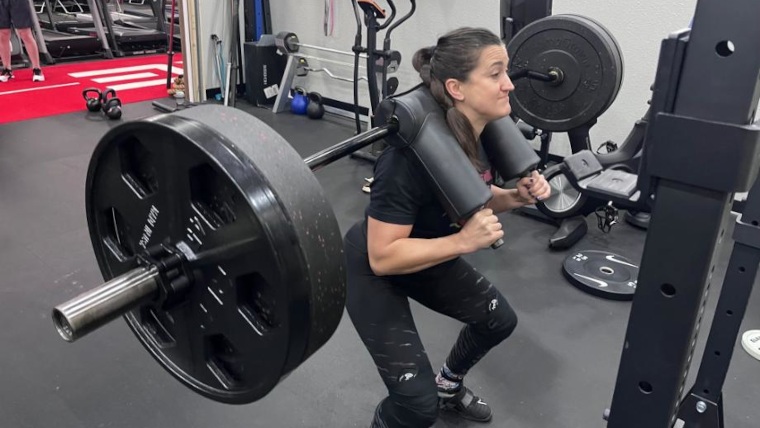
Many factors go into determining these numbers, including experience, age, gender, and current fitness level. Before worrying about what muscles squats work or loading up more plates on your bar, you can comb through these tables and start setting personal goals. Here’s a quick look at the math behind these squat standards.
| Fitness Level | Male Standard | Female Standard |
| Beginner | 0.80 x BW | 0.40 x BW |
| Novice | 1.15 x BW | 0.85 x BW |
| Intermediate | 1.45 x BW | 1.00 x BW |
| Advanced | 1.80 x BW | 1.35 x BW |
| Elite | 2.45 x BW | 1.80 x BW |
The weight amounts in all these charts reflect the one-rep maximum (1RM) for the corresponding body weight and gender. Along with consulting our in-house credentialed fitness experts, we researched other reputable sites — like Strength Log, Strength Level, and ExRx — to come up with these user-friendly, straightforward formulas. (2)(3) These formulas came from user-provided data on their body weight, gender, and squat maxes on popular fitness apps.
If terms like beginner or intermediate seem subjective — they are. Generally speaking, the BarBend team of experts defines these admittedly vague identifiers as follows.
- Beginner: A beginner is generally stronger than about 5% of lifters. They are comfortable performing the squat movement with proper technique, practicing it for about one month.
- Novice: A novice lifter is generally stronger than about 20% of weightlifters. They have been regularly performing the squat movement with proper technique for a minimum of six months.
- Intermediate: An intermediate athlete is generally stronger than about 50% of lifters. These people have been executing the squat movement with proper technique for at least two years.
- Advanced: An advanced athlete is generally stronger than about 80% of lifters, having progressed in overall strength and, of course, have been performing squats for about five years. These athletes have loads of experience with back squats, front squats, and many squat variations.
- Elite: Elite lifters are generally stronger than 95% of most athletes and have been considered competitive weightlifters for over five years. People in this class may have participated in powerlifting or bodybuilding competitions.
Regardless of your current skill level, Polish points out that averages are just that — averages. They don’t show you the upper and lower numbers, meaning that there’s nothing wrong with you or your lifting if you aren’t coming near these stats. “There’s no need to punish yourself — nor limit yourself! — based on what other people consider average. Plenty of very strong men can’t squat anywhere near their body weight, and plenty of beginner women start their lifting journey doing much heavier than the average numbers.”
Average Squat for Men
| Fitness Level | Male Average Squat (lbs) |
| Beginner | 159.8 |
| Novice | 229.8 |
| Intermediate | 289.7 |
| Advanced | 359.6 |
| Elite | 489.5 |
Averages were calculated by multiplying our formula (derived from user-generated lifts) by the average weight for men in the US from the CDC, which is 199.8 pounds. Please use the formula provided above to calculate the average numbers for your own body weight for a more customized benchmark. (1)
Squat Strength Standards for Men
| Bodyweight | Beginner | Novice | Intermediate | Advanced | Elite |
| 110 | 77 | 120 | 161 | 202 | 286 |
| 120 | 88 | 135 | 180 | 226 | 316 |
| 130 | 98 | 149 | 197 | 247 | 344 |
| 140 | 108 | 162 | 213 | 268 | 371 |
| 150 | 118 | 175 | 229 | 287 | 395 |
| 160 | 128 | 187 | 244 | 306 | 419 |
| 170 | 137 | 199 | 258 | 323 | 441 |
| 180 | 145 | 210 | 272 | 340 | 463 |
| 190 | 154 | 221 | 285 | 356 | 483 |
| 200 | 163 | 231 | 298 | 372 | 503 |
| 210 | 171 | 241 | 310 | 387 | 521 |
| 220 | 179 | 251 | 322 | 401 | 539 |
| 230 | 187 | 261 | 333 | 415 | 557 |
| 240 | 194 | 270 | 345 | 428 | 574 |
| 250 | 201 | 279 | 356 | 441 | 590 |
| 260 | 208 | 288 | 366 | 454 | 606 |
| 270 | 215 | 297 | 376 | 466 | 621 |
| 280 | 222 | 305 | 386 | 478 | 636 |
| 290 | 229 | 313 | 396 | 490 | 650 |
| 300 | 235 | 321 | 405 | 501 | 664 |
| 310 | 242 | 329 | 414 | 512 | 678 |
Average Squat for Women
| Fitness Level | Female Average Squat (lbs) |
| Beginner | 68.3 |
| Novice | 145.2 |
| Intermediate | 170.8 |
| Advanced | 230.6 |
| Elite | 307.4 |
Averages were calculated by multiplying our formula (derived from user-generated lifts) by the average weight for women in the US from the CDC, which is 170.8 pounds. Please use the formula provided above to calculate the average numbers for your own body weight for a more customized benchmark. (1)
Squat Strength Standards for Women
| Bodyweight | Beginner | Novice | Intermediate | Advanced | Elite |
| 90 | 41 | 81 | 122 | 165 | 215 |
| 100 | 46 | 87 | 129 | 175 | 230 |
| 110 | 50 | 93 | 137 | 184 | 243 |
| 120 | 54 | 98 | 143 | 192 | 256 |
| 130 | 58 | 103 | 149 | 200 | 267 |
| 140 | 62 | 108 | 155 | 207 | 278 |
| 150 | 65 | 113 | 161 | 214 | 288 |
| 160 | 69 | 117 | 166 | 220 | 298 |
| 170 | 72 | 121 | 171 | 228 | 307 |
| 180 | 75 | 126 | 176 | 232 | 315 |
| 190 | 79 | 129 | 180 | 238 | 324 |
| 200 | 81 | 133 | 185 | 243 | 332 |
| 210 | 84 | 137 | 189 | 248 | 339 |
| 220 | 87 | 710 | 193 | 253 | 347 |
| 230 | 90 | 144 | 197 | 258 | 354 |
| 240 | 92 | 147 | 201 | 263 | 360 |
| 250 | 95 | 150 | 204 | 267 | 367 |
| 260 | 97 | 153 | 208 | 272 | 373 |
How Much Should I Squat?
As former BarBend editor and certified strength and conditioning specialist Jake Boly lays out, the myriad benefits of squats have made this ubiquitous movement a staple for many athletes. “Do you have to squat? No — of course not. But, squats can help you build muscle, increase strength, develop great athleticism, enhance your posture, and even help you lose fat,” he says. “Before you do the movement, ensure that you perfect your squat form and take the necessary safety precautions.”
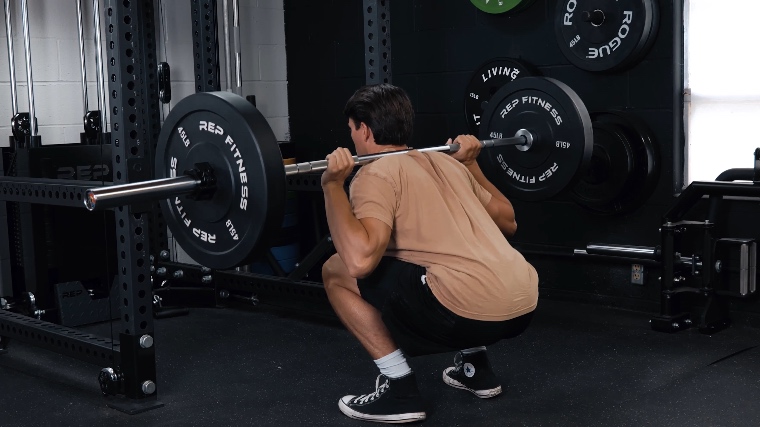
Prior to pinpointing just how much you should be squatting, remember to account for your current fitness level, experience with the movement, age, and gender. For instance, female lifters brand new to performing a squat may want to aim for around 40% of their body weight, while male lifters could try for 80%. Of course, many women will start lifting much heavier than that, and many men will start lifting much lighter. Meet yourself where you are at all times. As you progress, that percentage should increase as your overall strength improves. Revisit the chart at the beginning of this section to calculate a reasonable goal weight that corresponds with your fitness level.
How to Squat Heavier
As BarBend expert reviewer and certified strength and conditioning specialist Eric Bugera explains in his piece about common squat mistakes, the first checkpoint on your quest to squat heavier begins with proper form. “From rehab to hypertrophy, to strength and life itself, mastering the squat adds significant value to any training program,” he says. “However, errors in squat technique, if left unaddressed, may lead to plateaus in progress or injury.” Below are some of our team’s favorite tips for increasing strength on your way to squatting heavier.
Find a Program
In life and in squatting, failing to prepare is preparing to fail. So if you want to squat more, the answer is simple — make a plan. Or more accurately, follow a proven plan. There are plenty of time-tested training programs that can help boost your one-rep max, but finding a match might take some experimentation.
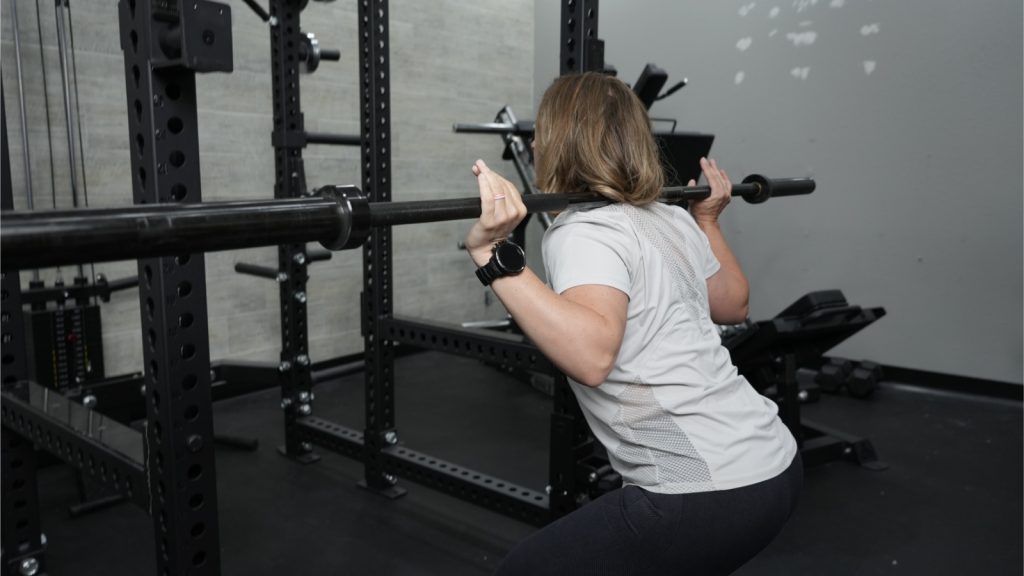
“Which squat program is the best? Whatever one works for you,” says BarBend expert reviewer and competitive weightlifter Samantha Poeth. For all the details, check out her full breakdown of famous back squat programs for weightlifters, but here’s a quick glance at her favorites to help you get started.
Implement Progressive Overload
“In a nutshell, progressive overload is a gradual and trackable increase of stress on the body to warrant a goal-oriented adaptation,” says certified strength and conditioning specialist Jake Boly. “When it comes to lifting, it’s basically a recipe to keep getting stronger.” Essentially, if you lift the same amount of weight over and over again, while repeating identical numbers of sets, reps, and rest periods, your strength can plateau.
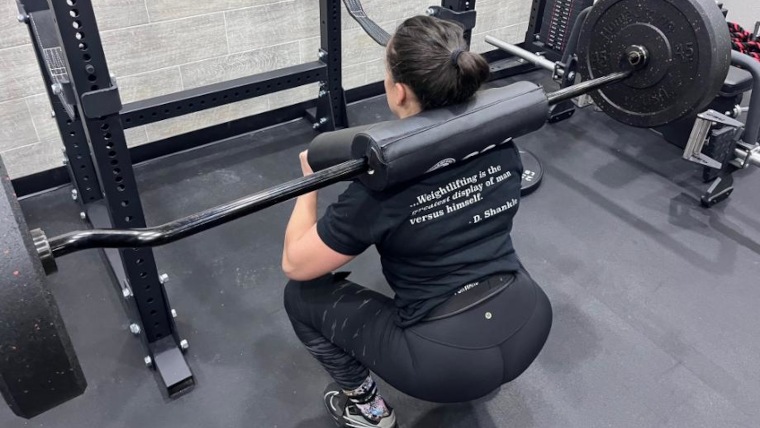
Adjusting these variables within your program can help you achieve the gains you’re after. For squats, that might include adding a set amount of weight to the bar at certain intervals in your program, but there’s more to it. “Overload does not just refer to more weight on the bar,” Boly adds. “Instead, it’s good to think about it in terms of stress — how can you add more positive stress to your training program? Think: Rest periods, reps, sets, time under tension, and training frequency.”
Master Your Technique
“There’s a lot that goes into a great squat. The un-rack, walkout, descent, and ascent all need to be perfectly aligned to move efficiently under a loaded bar,” Boly says when describing the necessary steps for a perfect squat. “An important lesson to learn under the barbell is that no two squats will ever look exactly the same, however, there are squat principles that should be carried out across every athlete’s form.”
Before you even step into the rack, performing some bodyweight squats can also be a good idea for people just starting strength training programs. In the below video, Boly and three-time IPF World Champion Taylor Atwood discuss some important techniques to help you squat heavier.
Plan Accessory Lifts Around Your Squat
While the classic barbell back squat is what many of us see when we visualize a squat, BarBend expert reviewer and certified personal trainer Shane McLean explains that accessory lifts like barbell good mornings, back extensions, or ab rollouts can help avoid common pitfalls in your training.
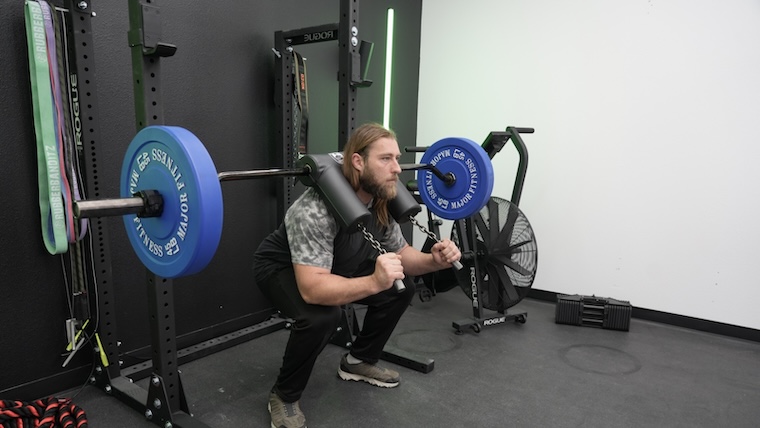
“To get better at [back squats], you need to spend some serious time under the bar,” McLean says in his article detailing the best squat accessory exercises. “But when you’re squatting hard and heavy for any period, dreaded plateaus are common. It’s key to have squat accessory exercises ready to take some load off the bar while ironing out any weaknesses.”
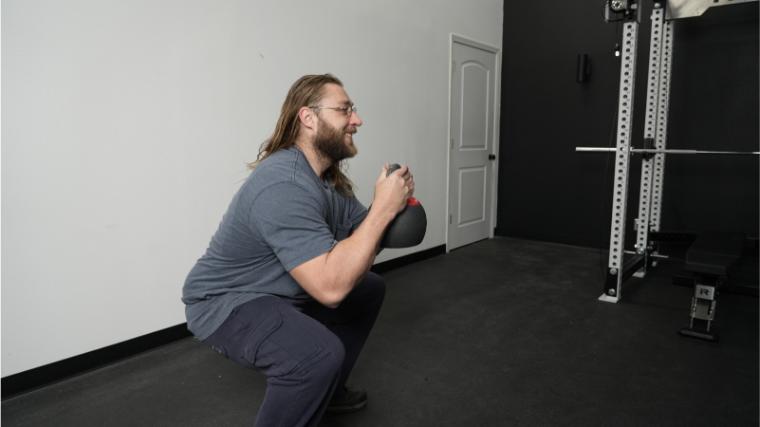
So, what is an accessory lift? Simply put, these movements help train and strengthen the muscle groups needed to optimally perform a barbell back squat. Many don’t even require a barbell. Kettlebells, dumbbells, TRX bands, or even your own body weight can support lower-body training and help pinpoint any soft spots in your technique.
Methodology
This Squat Standards piece references the one-rep max (1RM) you should shoot for at each phase of your fitness journey. We researched other reputable sites — including Strength Log, Strength Level, and ExRx — and our in-house credentialed experts examined the ranges and chose modest averages they believe are achievable and effective. (2)(3)
Squat Standards FAQs
How do I increase my squat weight?
Whether it’s a squat, bench press, overhead press, deadlift, or pull ups, make sure you follow the principle of progressive overload to increase your one-rep max. Our experts recommend identifying and committing to a proven, periodized plan that works for your current fitness level and equipment on hand.
Why can’t I squat heavy?
If your one-rep squat max is not as high as you’d like, there are several steps to take. First, focus on your form and work on perfecting your technique. Then, identify a proven strength training plan that can support the strength gains you’re after.
How rare is a 405-pound squat?
For most people, squatting 405 pounds is likely not a reasonable strength goal and only attainable by advanced and elite strength athletes. However, very high targets like this can be achieved with years of training.
Is a 285-pound squat good?
A one-rep maximum of 285 pounds would be a strong showing for male, female, and nonbinary athletes alike. After honing your form and gaining experience with the weight room, a 285-pound one-rep maximum could be a huge goal weight for front squats and a very good one for back squats.
References
- Centers for Disease Control and Prevention. (2021, September 10). FASTSTATS – body measurements. Centers for Disease Control and Prevention. https://www.cdc.gov/nchs/fastats/body-measurements.htm
- Squat strength standards for men and women (KG). StrengthLog. (2023b, March 15). https://www.strengthlog.com/squat-strength-standards-kg/
- Squat standards for men and women (LB). Strength Level. (n.d.). https://strengthlevel.com/strength-standards/squat/lb